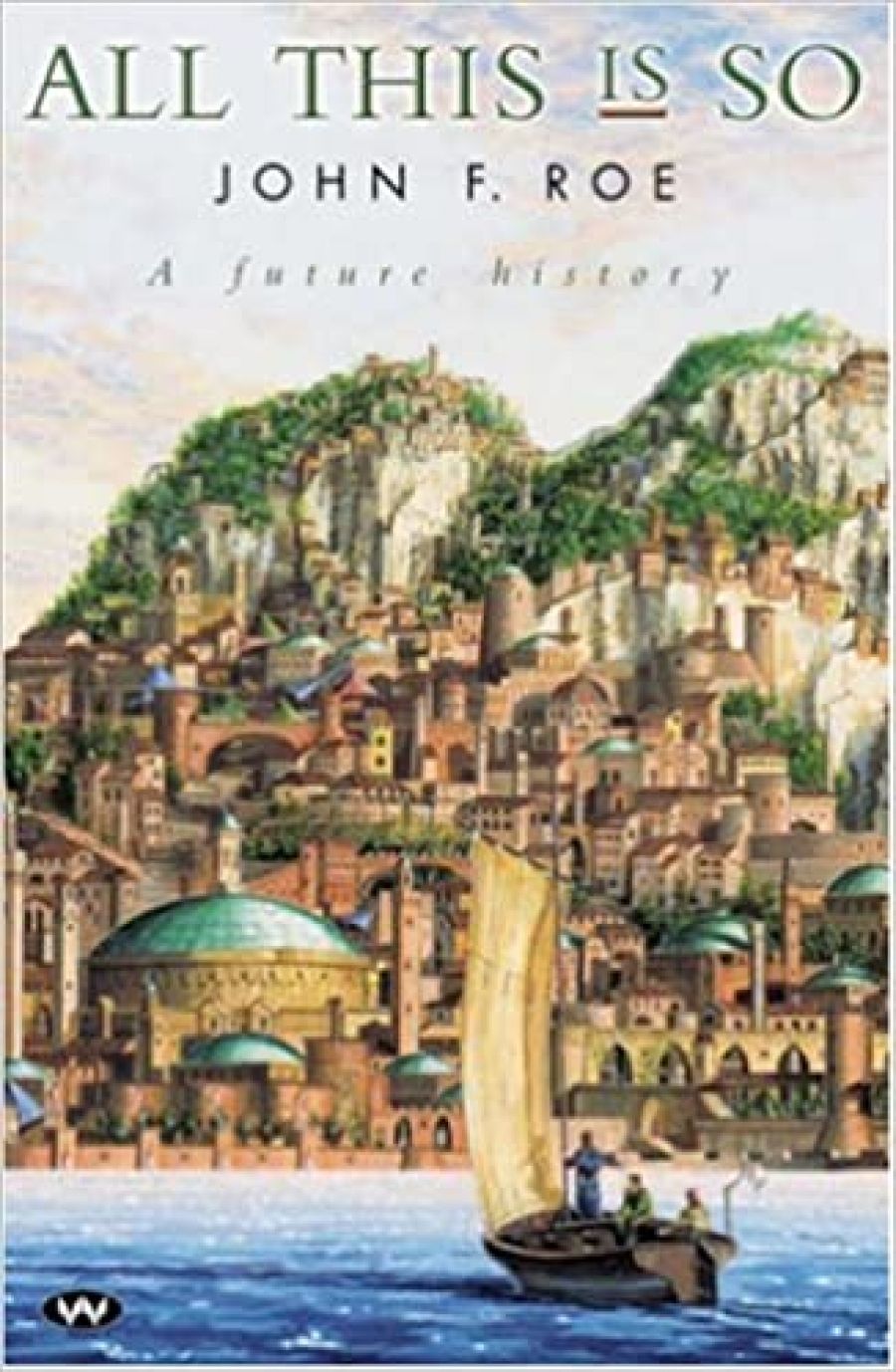
- Free Article: No
- Contents Category: Fiction
- Review Article: Yes
- Article Title: Archangels of Evolution
- Online Only: No
- Custom Highlight Text:
Much science and fantasy fiction is written in a predominantly realist mode. This is the most economical means of signifying the internal truth of its fictional worlds, no matter how strange its aliens, or how superhuman the powers of its heroes. So, for example, Tolkien writes, ‘Holding the hobbits gently but firmly, one in the crook of each arm, Treebeard lifted up first one large foot and then the other; and moved them to the edge of the shelf.’ Whatever his nature – half-Ent, half-tree – Treebeard comfortably occupies the grammatical subject position.
- Book 1 Title: All This Is So
- Book 1 Subtitle: A future history
- Book 1 Biblio: Wakefield Press, $27.50 pb, 505 pp
- Book 1 Readings Link: booktopia.kh4ffx.net/qnvxNb
A related convention of fantasy writing is to withhold the full explanation of the fantasy itself, or the nature of the imagined world, so that the reader must try and puzzle out the underlying system. Again, Treebeard says to Pippin, ‘I do not understand all that goes on myself, so I cannot explain it to you.’
John F. Roe’s fantasy novel All This Is So exploits both these conventions, the first more successfully than the second. It is a leisurely, even sprawling narrative, set in a post-industrial, post-technological, and post-electronic world (its subtitle is A Future History) inhabited by a number of different humanoid races, such as the Daylight People, the Unmen, the Daroi warriors, and so forth. Most disturbing are the Twisters, a race subject to a series of genetic malformations, some more serious than others. Whereas the Twister-heroine, KitFox, conceals her one fox’s paw with a stylish black glove, several Companions travel, questing deep into the novel’s heart of darkness – its Wasteland. This is the Glassy Kingdom, where horrific malformations are endured not only by men and women, but where even the birds are club-footed, and lose feathers whenever they fly:
Here everything seemed to inbreed, to distend into itself, to be squat, bloated, as if the land were ingurgitating every bud and foetus, intumescent in reverse, the snails oozing from their shells, the shabby trees sprouting a few mean leaves in a timid suggestion of green.
In a mode that also bears comparison with Philip Pullman, Roe constructs his fantasy world with persuasive force, in prose that is mostly stylish and sharp. Like Pullman, Roe rings a number of changes on the ‘real’ world, but not so many that we feel we must be on some other planet. For most of the book, however, the narrative perspective is myopic, small-scale, and partial. Authoritative explanations of even parts of the story are few and far between, especially in the long slow opening sections. It takes a substantial act of readerly will here to activate the kind of narrative curiosity most authors are eager to produce in their readers.
Part of the difficulty in reading this novel derives from Roe’s fascination with ideas of memory and memory loss, and those of archetypal and collective identity. He builds layers and layers of narrative patterning, across different levels of consciousness, and different orders of being, while also reserving the authorial right to withhold the key to those patterns as long as possible. So, for example, the character Orr becomes known later as Hereward, who may or may not be a version or reincarnation of the legendary Tyr, the saviour of his people. In the characters’ names – Hereward, Lamorak, Astolat, Marcantonio, Pergint, Shelley – the novel hints again and again at the deeper meanings and cultural allusions that might emerge from a fuller study of this text and its imagery. At the same time, there seem to be so many such allusions, and so many characters, that they can equally seem random, even undisciplined.
Sometimes this reach towards mystery is powerful: the shadowy Matrix, the dream that seems to hold most of these social structures in place, resists easy identification; and readers who enjoy the puzzle-solving aspect of fantasy fiction will enjoy working against Roe’s narratorial parsimony.
As the novel progresses, though, its emphasis shifts from relating a pseudo-medieval quest-adventure to articulating Roe’s philosophical concerns with post-technological identity and subjectivity, with the possibilities of tampering, genetically, with ‘the archangel of evolution’, and with intersections between composite and individual consciousness. These concerns are played out in longer metaphysical speeches and dialogues. These speculations hold their own fascination – even if only because, by the time they arrive, the reader is desperate for understanding – but Roe is also capable of the banal: ‘The occasion had become a story, the villagers’ favoured way of recalling past events.’
One thing remains constant in such fiction, however, and that is its nostalgia. It is hard to do nostalgia with much originality, but Roe pulls this off beautifully:
This parade of clear pools and gleaming kingfishers, and comfortable green turf was the world he had enjoyed briefly in Hay village, lifting sacks of grain, and watching spring unroll buttercups across the mill’s meadow so that the women of Hay knew to bring out their carpets and beat the dust from them, as if they were the swallows that also know their own meetings and departures.


Comments powered by CComment